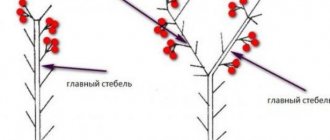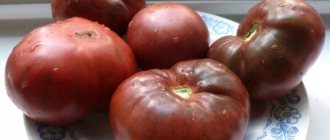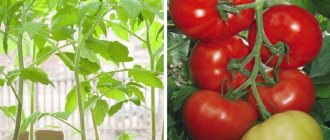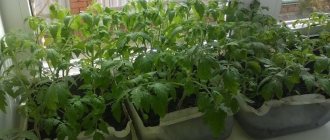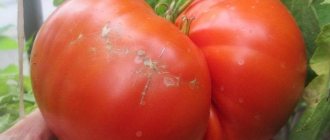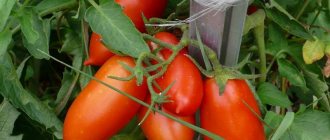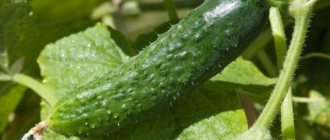Advantages and disadvantages
Pros:
- resistance to extremely low temperatures;
- good bush growth in low light;
- the ability to grow tomatoes both in a greenhouse and in open ground;
- immunity against common diseases;
- good formation of ovaries in poor climate;
- self-collection of seeds for subsequent planting;
- crop stability.
The only disadvantage of the crop is the average degree of yield. However, even this indicator fades into the background: the taste and structure of the fruit win.
Harvesting and using tomatoes
The harvest ripens together. If for some reason the fruits are not ripe on the bush, then the green tomatoes are cut off, leaving a small tail of the stem, and laid out in a warm, bright place until technically ripened.
Tomatoes are good both fresh and in culinary delights. They are used for making salads, pizza, soups, tomato paste and juice; they are suitable for pickles and savory snacks.
In which regions of Russia can Sanka tomato be grown?
Breeders recommend planting tomatoes of this variety in the Central Black Earth region. The culture grows well in the Lipetsk, Kursk, Belgorod, Voronezh, and Tambov regions. However, the lands of other regions also produce excellent harvests. Especially if the climate is warm, the fruits can be collected 2 times per season.
Ural
“Sanka” is also excellent for the climatic conditions of the Urals. Tomatoes are grown exclusively in open ground.
Siberia
In open ground, the bush does not grow higher than 30 cm; one cluster has about 5 fruits. Step-sonning is mandatory. To obtain the classic version of the bush, it is advisable to plant it in a greenhouse.
Moscow region and central Russia
The variety can be grown both in open ground and in a greenhouse. Thanks to its unpretentiousness, it grows well and bears fruit in the Moscow region.
Southern regions of Russia
In the south, tomatoes are planted in open ground in early May. Mulching is mandatory.
Planting tomato seeds
Due to the fact that in some regions of Russia the climate is not mild enough, it is recommended to plant tomatoes as seedlings rather than seeds.
Seed preparation
Before planting, the seeds are soaked in a weak solution of potassium permanganate. The floating seeds are removed, as they are empty and will not germinate. After this, the calibrated seed is washed under running water and soaked until a sprout appears: filled halfway with warm water.
Soaking tomato seeds
When soaking, the water must be changed three times a day.
If purchased seeds are used, they are planted dry, since manufacturers pre-process them.
Sowing seedlings
The seeds are laid out in rows in a box at a distance of 1 cm from each other in purchased soil mixed with garden soil, or in a mixture of peat, sand and turf. Planting depth is 2 cm. After this, the box is covered with film to form a mini-greenhouse. When the first shoots appear, the film is removed.
It is important to prevent the soil from drying out and provide good lighting. Seedlings can be planted in open ground when the bush has about 6 leaves and one ovary.
Hardening, picking seedlings
After 15-20 days, the seedlings are planted in large containers. At the same time as replanting, the roots of the bushes are pinched. Then the plants are well watered and shaded for 2-3 days.
Hardening is carried out at a temperature below room temperature by 5-6 degrees. The plant is left for 2 hours on the balcony or veranda. The procedure is carried out over several days, gradually increasing the duration of hardening.
Landing in the ground
Seeds are planted in mid-to-late March: approximately 2 months before planting seedlings. In the southern regions, seeds can be planted in the first weeks of spring.
It is advisable to choose open areas for planting with beds directed from north to south. 2-3 weeks before planting, the soil will need to be dug up and loosened well.
Fertilize the soil in 2 stages. In autumn, humus, potassium sulfate and superphosphate are added. In spring - nitrogen-containing fertilizer or wood ash.
Pests and diseases
When growing the Sanka tomato variety in some unfavorable years, you may encounter a number of problems. The most common of them are discussed below.
Late blight
A widespread fungal disease. Massive outbreaks occur in cold, rainy weather. The spread of the disease begins from the lower leaves. They begin to turn yellow and dry out. With further progression, the fruits begin to be damaged. First, dark spots appear on them. Then the tomatoes stop growing and begin to rot.
To combat late blight, copper-containing fungicides are used:
- Hom,
- Bordeaux mixture.
All parts of the plants are treated with the prepared solution. After 10 days, the treatment is repeated. To prevent the occurrence of late blight in the future, it is necessary to observe crop rotation. You cannot grow tomatoes in one place for several years in a row or plant them after other nightshade crops.
Aphid
Small sucking pest. Depending on the type, it is green or black.
Photo of aphids
Pest colonies abundantly cover young shoots and the underside of leaves. As a result, infected plants stop growing, damaged leaf blades curl into a tube and die.
When the number of aphids is small, a solution of ordinary laundry soap is used to destroy them, generously spraying all parts of the plants. For mass distribution, insecticides are used:
- Aktara,
- Commander,
- Alatar.
The dilution and use of drugs must be carried out in strict accordance with the attached instructions.
Planting tomatoes with seedlings
It is advisable to plant tomato seedlings in the northern regions of Russia, as well as in places where it is not possible to fertilize the soil well.
Preparing seedlings
Before planting, it is recommended to take the seedlings out into fresh air for 20-30 minutes every day for hardening. The duration of the procedure is 2 weeks.
Rules for planting in open ground
Planting is carried out after frosts at a temperature of +15 degrees and the soil warms up to +10-12 degrees. Be sure to first dig up the soil with manure or fertilizers. The rate of additives should be regulated, since an excess of microelements promotes stem growth, and the fruits are formed worse.
Before planting, you can fertilize the holes with Kornevin.
Seedlings are planted at a distance of 50-60 cm from each other in several rows. First, make a hole in the row and place the roots in it. After this, they are sprinkled with earth up to the cotyledon leaves.
If the seedlings are very elongated, cover ¼ of the stem. In this case, the bush is planted at an angle.
After planting, the root is compacted well, but there is no need to form a mound. Established bushes are watered abundantly and mulched with sand and peat.
Recommendations for caring for the variety
The variety is suitable for industrial cultivation, which means that care does not require much labor.
Watering rules
Sanka is watered based on weather conditions. In cool weather, weekly moisturizing is sufficient. When it rains, there is no need for watering.
Water should be applied at the root, avoiding wetting the stems and leaves. The roots of an adult plant are located in the top layer of soil, and it should be moistened to a depth of 30 cm.
In cool weather, you can water throughout the day, but in hot weather, the process is postponed until the evening or early morning. In this case, the difference in temperatures of air, soil and irrigation water is insignificant. When the temperature drops, do not water in the evening, so as not to create conditions for the proliferation of bacteria and fungi.
Feeding and fertilizers
Sanka needs to be fed three times during the growing season. Nitrogen fertilizers are applied for the first time, but not earlier than 10-15 days after planting.
During active flowering, potassium and phosphorus-containing compounds are added to the tomato “diet”. The same substances are added when the fruits ripen.
Bush formation
The bush does not need any special crown formation. Excess shoots are removed only from weakened plants. When planting thickly, no more than 3-4 shoots should be left on the main stem, otherwise the leaves will not have enough sunlight for photosynthesis, and stagnation of air will contribute to the emergence and active spread of bacterial diseases.
Excess shoots that interfere with care should also be removed, otherwise, as the plant grows, each time the grower risks damaging the plant.
Stepson or not?
Stepping is carried out only if necessary to prevent the beds from becoming dense. Otherwise, the yield will be significantly reduced. Only the stepsons below the first nests of flowers are removed.
Collecting seeds
Fully ripe fruits are selected for collecting seeds.
The appearance and weight of the tomato must comply with the standard. Fruits that exceed the norm may be the result of cross-pollination with other varieties growing on the site or among neighbors. The harvest grown from such hybrids can be an unpleasant surprise.
How to properly collect seeds, ferment them and store them is described in the article
Care
The tomato variety is unpretentious, but it has its own care characteristics.
Mulching and watering
The plant must be provided with moderate watering, avoiding excessive moisture. It is important that water does not get on the leaves, otherwise burns will form on them. The optimal frequency of watering is 1-2 times a week.
Tomatoes should be watered at the root
Mulching is also useful for Sanka tomatoes. Weeding helps retain moisture and provide oxygen to the roots.
Bush formation and pinching
Pruning is not required for this crop. A garter is only necessary in a greenhouse or if the bush bends to the ground under the weight of the fruit.
Top dressing
It is better to fertilize with organic matter in combination with industrial products (any mineral fertilizer will do).
- 2 weeks after planting: 0.5 liters of chicken manure per 10 liters of water (an alternative is nettle infusion).
- 20 days after 1 treatment: 0.5 mullein per 10 liters of water + 1 tbsp. l of any mineral fertilizer.
- 20 days after 2 treatments: 1 tbsp. l of mineral fertilizer per 10 l of water.
Varietal characteristics
The Sanka variety is characterized by a determinant growth type. After reaching a height of 60-70 cm, the laying of flower clusters stops. The variety forms well-leafed bushes with medium-sized leaves. In this case, the first inflorescence is formed after the 7th leaf.
According to the description of the variety, the Sanka tomato has rounded, red fruits with an average weight of about 100 grams. The assessment of the tomato's taste is average; they are characterized by a well-pronounced sourness. Subject to proper growing conditions, yields reach up to 2.5 kg per plant.
Advantages of the variety:
- High yield.
- Early ripening - the bulk of the fruits have time to ripen before late blight spreads.
- Unpretentiousness - can be grown without shaping and gartering.
No particular deficiencies were identified in the variety.
Reviews about the variety
What can those who planted the Sanka tomato say? Of course, gardeners have only positive reviews. They note that the variety is unpretentious in care, the fruits form quickly, and if planted in a greenhouse, the Sanka variety will be the very first to harvest.
Alevtina, 38 years old, Kostroma region.
We live in the north. We grow tomatoes in a greenhouse. “Sanka” is the very first to ripen. Sores don’t bother him, he doesn’t need to be bothered. For my taste, the tomatoes lack sweetness, but they are very good when preserved.
Sanka and other early tomatoes: comparison
The catalog of the State Register of the Russian Federation lists several tomatoes with similar names:
- "Sanya";
- "Sanyushka";
- "Sasha";
- "San Sanych."
The fruitful and tasty hybrid F1 “Sasha” (cherry), as well as the tomato “Sanka golden” (with yellow fruits), are not registered in the State Register. Please note that these are all different varieties and hybrid forms that are not related to “Sanka”.
Many compare this tomato with other early tomatoes, noting its ease of care.
